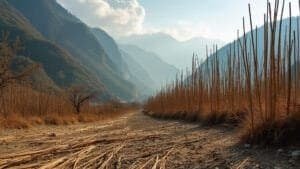Introduction
Red pandas are uniquely adapted to the temperate forests of the Eastern Himalayas, relying on stable rainfall patterns to sustain their habitats and food sources. However, climate change-induced alterations in precipitation are threatening their survival
Irregular rainfall, including prolonged droughts and excessive downpours, disrupts bamboo growth, a critical food source for red pandas. These changes also lead to habitat fragmentation and force red pandas to migrate to less suitable areas, increasing their vulnerability
This article explores the effects of changing rainfall patterns on red panda survival, the challenges posed by drought and flooding, and the conservation strategies needed to address these issues
The Role of Rainfall Patterns in Red Panda Habitats
Rainfall patterns play a crucial role in maintaining the health and stability of ecosystems inhabited by red pandas
These high-altitude temperate forests, spanning the Eastern Himalayas and parts of southwestern China, are heavily reliant on consistent precipitation to support bamboo, the primary food source for red pandas
Altered rainfall patterns, driven by climate change, disrupt these ecosystems, impacting red pandas at multiple levels
Importance of Stable Precipitation for Bamboo Ecosystems
Bamboo is an integral component of red panda habitats, not only providing sustenance but also contributing to the overall ecological balance of these forests
Stable rainfall is essential for bamboo growth, which thrives in conditions with moderate and consistent moisture. Deviations from normal precipitation patterns can disrupt the delicate lifecycle of bamboo, which includes flowering, seeding, and regeneration
A 2022 study in Forest Ecology and Management found that bamboo species in red panda habitats exhibit reduced growth rates during periods of drought, resulting in lower biomass availability
Furthermore, erratic rainfall patterns can delay flowering cycles, leading to prolonged periods during which food is scarce. For red pandas, whose diet comprises up to 90% bamboo, such disruptions can lead to malnutrition and starvation
Rainfall also supports the undergrowth and water sources that sustain the broader ecosystem. Streams and rivers in red panda habitats depend on regular precipitation to maintain flow levels
Reduced rainfall impacts these water sources, further compounding the challenges faced by red pandas and other species sharing these habitats
Shifts in Rainfall and Seasonal Impacts
Seasonal changes in rainfall are natural, but climate change is exacerbating their variability, making precipitation more erratic and intense. The monsoon season, which traditionally replenishes Himalayan forests, has shown increasing unpredictability in recent years
A 2023 report by the Journal of Environmental Sciences highlighted how delayed monsoon onset and concentrated downpours disrupt red panda habitats by causing both drought-like conditions and flooding within a short timeframe
During dry spells, bamboo and other vegetation suffer from moisture stress, leading to reduced growth and declining habitat quality. Conversely, excessive rainfall can lead to waterlogging, which negatively affects bamboo root systems, causing decay and stunted growth
These alternating extremes create an unstable environment, forcing red pandas to migrate in search of suitable habitats, often at higher elevations or across fragmented landscapes
Additionally, changing rainfall patterns disrupt seasonal availability of bamboo shoots, a preferred and nutritionally dense part of the plant. Red pandas rely heavily on the predictable emergence of these shoots during certain times of the year
Disrupted rainfall schedules result in fewer shoots, depriving red pandas of critical nutrients during key periods like the breeding season
Impacts of Drought and Excessive Rainfall on Bamboo Growth
Bamboo, the primary food source for red pandas, is highly sensitive to changes in precipitation. Both drought and excessive rainfall significantly disrupt bamboo growth, creating cascading effects on red panda survival
These extreme conditions, increasingly driven by climate change, pose a dual threat to the delicate balance of red panda ecosystems
Drought Effects on Bamboo Availability
Drought conditions, characterized by prolonged periods of below-average rainfall, lead to severe water stress in bamboo plants
A 2021 study published in Climate Change Ecology examined the impact of reduced precipitation on bamboo forests in Nepal and found a 35% decrease in shoot production during drought years
This reduction not only limits the quantity of food available to red pandas but also affects its quality, as water-stressed bamboo contains lower concentrations of essential nutrients
Water stress impairs bamboo’s photosynthesis and root growth, resulting in weaker plants that are more susceptible to diseases and pest infestations
Red pandas, in turn, must expend additional energy searching for viable food sources, increasing their vulnerability to predators and other environmental stressors. Drought also forces red pandas to travel longer distances to access water, further straining their already limited energy reserves
The cyclical flowering and regeneration of bamboo are also disrupted by drought. Bamboo forests rely on a balance of moisture and temperature to trigger these cycles, which are critical for sustaining long-term food supplies
Drought-induced delays or failures in flowering can lead to localized food shortages lasting years, compounding the challenges for red panda populations already struggling with habitat loss
Excessive Rainfall and Waterlogging Challenges
While drought poses clear threats, excessive rainfall presents its own set of challenges. Waterlogged soils, resulting from heavy or prolonged rainfall, create anaerobic conditions that are detrimental to bamboo root systems
A 2022 study in Forest Ecology and Management reported a 20% decline in bamboo growth in areas experiencing unseasonable heavy rainfall in northeastern India. Saturated soils reduce oxygen availability for roots, leading to root rot and decreased plant vigor
Excessive rainfall can also accelerate soil erosion, particularly on the steep slopes where red panda habitats are located. This erosion not only washes away bamboo but also destabilizes the terrain, increasing the risk of landslides
Such events destroy large swaths of habitat in a single occurrence, displacing red pandas and fragmenting their populations
Flooding caused by excessive rainfall poses additional risks. Floodwaters can carry pollutants and pathogens into bamboo forests, further degrading habitat quality
In extreme cases, flooding can drown bamboo plants or prevent seedlings from establishing, reducing forest regeneration rates
Combined Effects on Red Panda Survival
The combination of drought and excessive rainfall creates an unpredictable environment that disrupts the availability of bamboo year-round. During droughts, red pandas face shortages in food and water, leading to malnutrition and decreased reproductive success
Conversely, during periods of excessive rainfall, their habitats become unstable and prone to destruction, forcing them to migrate or adapt to less suitable conditions
These changes in bamboo availability also influence red panda behavior and movement patterns. For instance, red pandas may be forced to encroach on human settlements in search of food, increasing the risk of human-wildlife conflict
Additionally, fragmented and degraded habitats make it harder for red pandas to find mates, further threatening their already vulnerable populations
Understanding the impacts of both drought and excessive rainfall on bamboo growth is critical for devising effective conservation strategies. By addressing these challenges, researchers and conservationists can help ensure the long-term survival of red pandas in the face of changing rainfall patterns
Habitat Fragmentation and Population Isolation
Changing rainfall patterns contribute significantly to habitat fragmentation and population isolation for red pandas
These phenomena, exacerbated by climate-driven shifts in precipitation, disrupt the connectivity of red panda habitats, creating isolated populations with reduced genetic diversity and limited resources
Shifting Elevation Ranges Due to Rainfall Changes
Red pandas are highly dependent on specific climatic conditions found within narrow altitudinal ranges, typically between 8,200 and 13,800 feet
Changes in rainfall patterns force red pandas to adjust their distribution, often driving them to higher elevations in search of stable food supplies and suitable habitats
A study published in Nature Climate Change (2022) highlighted how reduced rainfall at lower elevations has led to declines in bamboo coverage, pushing red pandas into higher-altitude areas where bamboo remains more resilient. However, higher elevations often have steeper slopes and harsher conditions, which may not fully support red panda populations
Additionally, as rainfall variability increases, red pandas may experience further displacement, leading to increased competition for limited resources in these already constrained habitats
Such shifts also disrupt the natural migration patterns of red pandas, as habitat corridors connecting lower and higher elevations become unsuitable. This fragmentation isolates populations, restricting their ability to move freely and find mates, which is critical for maintaining genetic diversity
Consequences of Fragmented Habitats on Genetic Diversity
Habitat fragmentation caused by erratic rainfall creates isolated red panda populations, which are at greater risk of genetic bottlenecks
Limited gene flow between fragmented populations results in reduced genetic variability, weakening the overall resilience of red pandas to diseases and environmental changes
A 2021 study in Biodiversity Research examined red panda populations in Nepal and found that isolated groups had lower genetic diversity compared to populations in contiguous habitats. This lack of diversity increases the likelihood of inbreeding, which can lead to a higher prevalence of genetic disorders and reduced reproductive success
Fragmented habitats also limit the availability of suitable nesting sites and food sources, forcing red pandas to compete for dwindling resources within their isolated patches
Smaller, isolated populations are more vulnerable to extinction due to stochastic events such as disease outbreaks, forest fires, or extreme weather
Secondary Effects of Habitat Fragmentation
In addition to its direct impacts on red panda populations, habitat fragmentation caused by changing rainfall patterns affects other species and ecological processes. For example, the loss of vegetation connectivity reduces the effectiveness of predator-prey dynamics and disrupts the ecological balance of the forests
These broader disruptions indirectly affect red pandas by altering their food web and increasing the presence of potential predators or competitors
Fragmented habitats also increase the likelihood of human-wildlife conflict. As red pandas are forced into smaller or degraded patches, they may encroach on agricultural lands or human settlements, leading to negative interactions that can further endanger their populations
Addressing Fragmentation Through Conservation
Efforts to combat habitat fragmentation include the establishment of protected corridors and reforestation projects designed to connect isolated red panda populations
These measures aim to restore habitat continuity, allowing red pandas to migrate and maintain genetic exchange. For example, Nepal’s Panchthar-Ilam-Taplejung corridor initiative focuses on linking fragmented habitats, ensuring red pandas have access to resources and mates across their range
Understanding how rainfall-induced habitat fragmentation affects red pandas is critical for designing conservation strategies that mitigate these impacts
By maintaining connectivity and addressing the underlying causes of fragmentation, conservationists can help ensure the long-term survival of red panda populations in the wild
Conservation Strategies for Red Pandas Amid Rainfall Changes
Addressing the impacts of changing rainfall patterns on red panda survival requires targeted conservation strategies that mitigate habitat degradation, ensure food availability, and promote species resilience
By integrating habitat restoration, adaptive management, and climate-focused policies, conservationists can counter the challenges posed by erratic precipitation
Habitat Restoration and Reforestation Projects
Habitat restoration is a cornerstone of red panda conservation, particularly in areas affected by drought, excessive rainfall, and fragmentation
Reforestation projects, which focus on planting native tree and bamboo species, help rebuild degraded habitats and provide critical resources for red pandas
For instance, in Bhutan, reforestation initiatives have targeted high-altitude forests where bamboo growth has declined due to erratic rainfall. These projects not only restore bamboo availability but also stabilize soils to prevent erosion and landslides exacerbated by heavy rains
A 2023 report by the World Wildlife Fund (WWF) highlighted the success of such efforts in creating more resilient ecosystems capable of withstanding variable precipitation patterns
Protected area expansion is another effective strategy. By designating larger regions as conservation zones and connecting these with wildlife corridors, governments and conservation organizations can facilitate the movement of red pandas across fragmented habitats
Nepal’s Panchthar-Ilam-Taplejung corridor is a prime example, aiming to link isolated populations and counteract the effects of rainfall-induced habitat fragmentation
Climate-Adaptive Conservation Approaches
Adaptive management practices are essential for addressing the unpredictable impacts of changing rainfall patterns
These strategies involve continuous monitoring of red panda habitats and implementing flexible conservation measures based on observed changes:
Bamboo Planting Programs: To counter food shortages caused by rainfall variability, conservationists have introduced bamboo planting programs in key red panda habitats. These initiatives focus on planting drought-resistant and flood-tolerant bamboo species to ensure long-term food security
Water Resource Management: Installing water retention systems, such as small reservoirs or rainwater harvesting structures, helps maintain water availability during dry spells. These measures benefit not only red pandas but also other wildlife and local communities that depend on the same resources
Climate-focused policies, such as those aimed at reducing deforestation and promoting sustainable land use, also play a vital role
For example, China’s Grain for Green program has successfully reforested degraded lands, indirectly supporting red panda populations by improving habitat quality
Engaging Local Communities in Conservation
Local communities are critical stakeholders in red panda conservation. Community-based programs that involve residents in habitat monitoring and restoration efforts have proven effective in addressing the challenges posed by changing rainfall patterns
In Nepal, initiatives such as the Red Panda Network’s Forest Guardian program empower local villagers to monitor red panda habitats, report illegal logging, and participate in reforestation efforts
These programs not only protect red panda habitats but also provide alternative livelihoods, reducing reliance on activities that degrade the environment
Additionally, environmental education campaigns raise awareness about the importance of red panda conservation and the impacts of climate change. Engaging local communities fosters a sense of stewardship, ensuring long-term support for conservation initiatives
Leveraging Technology for Monitoring and Adaptation
Technological advancements, such as satellite imagery and remote sensing, are increasingly used to monitor changes in rainfall patterns and their effects on red panda habitats. These tools allow conservationists to identify areas at risk of drought or flooding and prioritize interventions accordingly
Camera traps, combined with AI-powered analysis, provide detailed insights into red panda movements and habitat use. By tracking how red pandas respond to changing rainfall patterns, researchers can refine conservation strategies to address emerging threats
Collaboration and Policy Advocacy
Conservation efforts require collaboration among governments, non-governmental organizations, and local communities
International agreements, such as the Convention on Biological Diversity (CBD), emphasize the need for coordinated action to protect species like the red panda from climate-related threats
Policy advocacy is also essential for ensuring that climate change mitigation and adaptation are integrated into national and regional conservation plans. By prioritizing red panda habitats in climate adaptation strategies, governments can address the root causes of rainfall variability and its ecological impacts
Conservation strategies that integrate habitat restoration, adaptive management, community engagement, and technological innovation provide a comprehensive approach to addressing the challenges posed by changing rainfall patterns
These efforts are essential for ensuring the long-term survival of red pandas in the wild
Conclusion
Changing rainfall patterns, driven by climate change, pose a significant threat to red panda survival in the wild
These erratic precipitation changes disrupt bamboo growth, the primary food source for red pandas, and destabilize their habitats through droughts, waterlogging, and forest fragmentation
The cascading effects include food shortages, increased vulnerability to predators, and isolation of populations, all of which jeopardize the long-term viability of this endangered species
Conservation strategies must address these challenges through a combination of habitat restoration, climate-adaptive management, and community engagement. Initiatives such as reforestation projects, bamboo planting programs, and wildlife corridors are critical for countering the impacts of habitat degradation and fragmentation
Engaging local communities as stewards of red panda habitats further ensures sustainable conservation outcomes, while technological advancements provide invaluable tools for monitoring and responding to changing environmental conditions
The integration of these strategies into national and international conservation policies is essential for mitigating the effects of climate-induced rainfall variability
By prioritizing red panda habitats and addressing the root causes of habitat loss, we can create a future where this iconic species thrives despite the challenges posed by a changing climate





